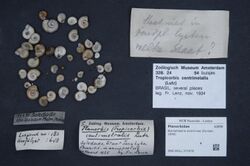Biology:Biomphalaria straminea
| Biomphalaria straminea | |
|---|---|

| |
| Shells of Biomphalaria straminea | |
| Scientific classification | |
| Domain: | Eukaryota |
| Kingdom: | Animalia |
| Phylum: | Mollusca |
| Class: | Gastropoda |
| Subclass: | Heterobranchia |
| Superorder: | Hygrophila |
| Family: | Planorbidae |
| Genus: | Biomphalaria |
| Species: | B. straminea
|
| Binomial name | |
| Biomphalaria straminea (Dunker, 1848)
| |
| Synonyms | |
|
Planorbis stramineus | |
Biomphalaria straminea is a species of air-breathing freshwater snail, an aquatic pulmonate gastropod mollusk in the family Planorbidae, the ram's horn snails.
This snail is a medically important pest,[1] because an intermediate host for the parasite Schistosoma mansoni and a vector of schistosomiasis.[2]
The history of these discoveries was summarized by Paraense (2001).[3]
The shell of this species, like all planorbids is sinistral in coiling, but is carried upside down and thus appears to be dextral.
Distribution
Biomphalaria glabrata is a Neotropical[1] species. It occurs in:
- Caribbean: Saint Lucia – reported since 1993[4]
- northeast of Brazil
This species has recently expanded its native range.[1] As an introduced species, it occurs in:
- Hong Kong and Southern China - firstly collected in 1973[5] in the Lam Tsuen valley in Hong Kong, in has now been identified at a number of locations in Hong Kong and Guangdong Province.[6]
Phylogeny
To allow comparisons with other mollusc genomes, a high-quality genome assembly for B. straminea together with accompanying transcriptomes has been sequenced, producing a 1.005 Gb in size reference genome consisting of 36 chromosomes.[7]
A cladogram showing phylogenic relations of species in the genus Biomphalaria:[8]
| Biomphalaria |
| ||||||||||||||||||||||||||||||||||||||||||||||||||||||||||||||||||||||||||||||||||||||||||||||||||||||||||||||||||||||||||||||||||||||||||||||||
Parasites
Biomphalaria straminea is an intermediate host for Schistosoma mansoni and a vector of intestinal schistosomiasis. Schistosoma mansoni came to Neotropics from Africa in context of the slave trade.[8] Schistosoma mansoni was not able to infect Biomphalaria straminea previously and it has adapted to this host.[8]
References
- ↑ 1.0 1.1 1.2 "Biological invasions: the case of planorbid snails". Journal of Helminthology 79 (3): 249–56. September 2005. doi:10.1079/JOH2005292. PMID 16153319.
- ↑ "Biomphalaria tenagophila potencial vector of Schistosoma mansoni in the Paraná River basin (Argentina and Paraguay)". Memórias do Instituto Oswaldo Cruz 102 (2): 191–195. March 2007. doi:10.1590/s0074-02762007005000022. PMID 17426884.
- ↑ "The Schistosome Vectors in the Americas". Memórias do Instituto Oswaldo Cruz 96 (supplement): 7–16. 2001. doi:10.1590/S0074-02762001000900002. PMID 11586421. http://memorias.ioc.fiocruz.br/96sup/13xbg.html.
- ↑ "The introduction of Melanoides tuberculata (Mollusca: Thiaridae) to the island of Saint Lucia (West Indies) and its role in the decline of Biomphalaria glabrata, the snail intermediate host of Schistosoma mansoni". Acta Tropica 54 (1): 13–18. 1993. doi:10.1016/0001-706x(93)90064-i. PMID 8103624. https://www.researchgate.net/publication/15094876.
- ↑ "A snail intermediate host of Schistosoma mansoni introduced into Hong Kong". Bulletin of the World Health Organization 51 (6): 661. 1974. PMID 4549615.
- ↑ Attwood, Stephen W.; Huo, Guan-Nan; Qiu, Jian-Wen (2015-01-01). "Update on the distribution and phylogenetics of Biomphalaria (Gastropoda: Planorbidae) populations in Guangdong Province, China" (in en). Acta Tropica. Progress in research and control of helminth infections in Asia 141 (Pt B): 258–270. doi:10.1016/j.actatropica.2014.04.032. ISSN 0001-706X. PMID 24811366. https://www.sciencedirect.com/science/article/pii/S0001706X14001557.
- ↑ Nong, Wenyan; Yu, Yifei; Aase-Remedios, Madeleine E; Xie, Yichun; So, Wai Lok; Li, Yiqian; Wong, Cheuk Fung; Baril, Toby et al. (2022-01-01). "Genome of the ramshorn snail Biomphalaria straminea—an obligate intermediate host of schistosomiasis". GigaScience 11: giac012. doi:10.1093/gigascience/giac012. ISSN 2047-217X. PMID 35166339. PMC 8848322. https://doi.org/10.1093/gigascience/giac012.
- ↑ 8.0 8.1 8.2 "Evolutionary relationships and biogeography of Biomphalaria (Gastropoda: Planorbidae) with implications regarding its role as host of the human bloodfluke, Schistosoma mansoni". Molecular Biology and Evolution 18 (12): 2225–39. December 2001. doi:10.1093/oxfordjournals.molbev.a003769. PMID 11719572.
Further reading
- "Prediction of the potential global distribution for Biomphalaria straminea, an intermediate host for Schistosoma mansoni". PLOS Neglected Tropical Diseases 12 (5): e0006548. May 2018. doi:10.1371/journal.pntd.0006548. PMID 29813073.
Wikidata ☰ Q3285340 entry
 |

